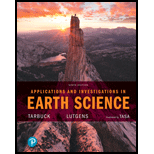
Place each of the igneous rocks supplied by your instructor on a numbered piece of paper. Then complete the igneous rock chart in Figure 2.12 and identify each specimen. To identify an igneous rock, follow these steps.
 Step 1: Identify the texture of the rock.
Step 1: Identify the texture of the rock.
Step 2: Determine the minerai composition of the rock by
a. Identifying the abundance of major minerals
or
b Estimating the mineral composition USing the color index
Step 3: Use the Igneous rock identification key In Figure 2.10 to identify the rock.
Learn your wayIncludes step-by-step video

Chapter 2 Solutions
Applications and Investigations in Earth Science (9th Edition)
Additional Science Textbook Solutions
Microbiology: An Introduction
The Cosmic Perspective (8th Edition)
Cosmic Perspective Fundamentals
Human Anatomy & Physiology (2nd Edition)
Introductory Chemistry (6th Edition)
Biology: Life on Earth with Physiology (11th Edition)
- As the atmosphere and ocean move, they are deflected due to the spin of the earth. Is the deflection to the right or to the left in the Northern Hemisphere? Is this the same in the Southern Hemisphere ? In both hemispheres, a low pressure will instigate cyclonic flow. In the Northern Hemisphere, does cyclonic flow circulate in a clockwise or counter-clockwise direction and whyarrow_forwardIs the seasonal cycle in temperature (temperature difference between warmest and coolest season) stronger in the tropics or high latitudes, and why ?How about in “maritime” areas that are regularly exposed to air that was recently over the ocean versus more continental areas, and why?arrow_forwardThe image shows the two different crusts on earth. Fill in the blanks with short answers (numbered as 1,2,3, and 4) for the rock types and the name of the crust. Question 3 options: Blank # 1 Blank # 2 Blank # 3 Blank # 4arrow_forward
- you are working on a crew and you overhear one of the people on the crew tell a member of the general public something that is not true. what do you do?arrow_forwardResearch question ideas for Benthic invertebrates as an indicator species for climate change, mapping changes in ecosystems (Historical Analysis & GIS) use where questionsarrow_forwardResearch question ideas for Benthic invertebrates as an indicator species for climate change, mapping changes in ecosystems (Historical Analysis & GIS) use where questionsarrow_forward
- Brief background for supporting of efforts should be made to create distance and separate crops that produce pollutants such as ecoli (i.e. animal farming) from crops that don’t (i.e. lettuce) to protect these latter crops despite the extra costs and logistical challenges.arrow_forwardOpening statement for supporting of efforts should be made to create distance and separate crops that produce pollutants such as ecoli (i.e. animal farming) from crops that don’t (i.e. lettuce) to protect these lattercrops despite the extra costs and logistical challenges.arrow_forwardInstructions Chapter 1. Philosophy and Fundamental concepts In this chapter, we discussed the five fundamental concepts of environmental geology: human population growth, sustainability, systems and change, hazardous Earth processes, and scientific knowledge and values. One interesting analogy for Earth is the Gaia hypothesis, which proposes that living organisms interact with their inorganic surroundings to form a synergistic, self-regulating system that helps maintain and sustain conditions for life on the planet. Now my question is Do you think the Earth is a living organism? Why or why not? I understand that many students use generative AI to assist with homework. While AI is undoubtedly a valuable tool for providing information, I believe that human judgment and analytical skills surpass what AI can achieve. My hope is that these assignments will help develop and strengthen your critical thinking skills. Here are answers from Chatgpt: "Do you think the Earth is a…arrow_forward
- what would you do if you're working in a group and you notice that the group is not functioning productively (no work being done)arrow_forwardwhat kind of attitude or demeanor would you bring when getting to know supervisor or colleaguearrow_forwardIn this course, we examine how social, economic, political and cultural processes transform relationships between people and the spaces they inhabit. Globalization is one of the key processes shaping human geographies in the 21st century. Although globalization operates at a planetary scale, its effects are felt in the spaces and routines of daily life. For this assignment, you are asked you to observe and analyze how globalization manifests in your own everyday experiences. Objectives • • Apply core geographic concepts of place, space and scale • Identify concrete examples of how global processes shape local contexts • Develop skills in observation and analysis Instructions 1. Choose two aspects of daily life from the following list that you will use to explore the influences of globalization: ○ Material goods - commodities, food ○ Media & entertainment о Technology & communication о Social connections and relationships O Linguistic or cultural landscapes 2. For each aspect, identify…arrow_forward
 Applications and Investigations in Earth Science ...Earth ScienceISBN:9780134746241Author:Edward J. Tarbuck, Frederick K. Lutgens, Dennis G. TasaPublisher:PEARSON
Applications and Investigations in Earth Science ...Earth ScienceISBN:9780134746241Author:Edward J. Tarbuck, Frederick K. Lutgens, Dennis G. TasaPublisher:PEARSON Exercises for Weather & Climate (9th Edition)Earth ScienceISBN:9780134041360Author:Greg CarbonePublisher:PEARSON
Exercises for Weather & Climate (9th Edition)Earth ScienceISBN:9780134041360Author:Greg CarbonePublisher:PEARSON Environmental ScienceEarth ScienceISBN:9781260153125Author:William P Cunningham Prof., Mary Ann Cunningham ProfessorPublisher:McGraw-Hill Education
Environmental ScienceEarth ScienceISBN:9781260153125Author:William P Cunningham Prof., Mary Ann Cunningham ProfessorPublisher:McGraw-Hill Education Earth Science (15th Edition)Earth ScienceISBN:9780134543536Author:Edward J. Tarbuck, Frederick K. Lutgens, Dennis G. TasaPublisher:PEARSON
Earth Science (15th Edition)Earth ScienceISBN:9780134543536Author:Edward J. Tarbuck, Frederick K. Lutgens, Dennis G. TasaPublisher:PEARSON Environmental Science (MindTap Course List)Earth ScienceISBN:9781337569613Author:G. Tyler Miller, Scott SpoolmanPublisher:Cengage Learning
Environmental Science (MindTap Course List)Earth ScienceISBN:9781337569613Author:G. Tyler Miller, Scott SpoolmanPublisher:Cengage Learning Physical GeologyEarth ScienceISBN:9781259916823Author:Plummer, Charles C., CARLSON, Diane H., Hammersley, LisaPublisher:Mcgraw-hill Education,
Physical GeologyEarth ScienceISBN:9781259916823Author:Plummer, Charles C., CARLSON, Diane H., Hammersley, LisaPublisher:Mcgraw-hill Education,





